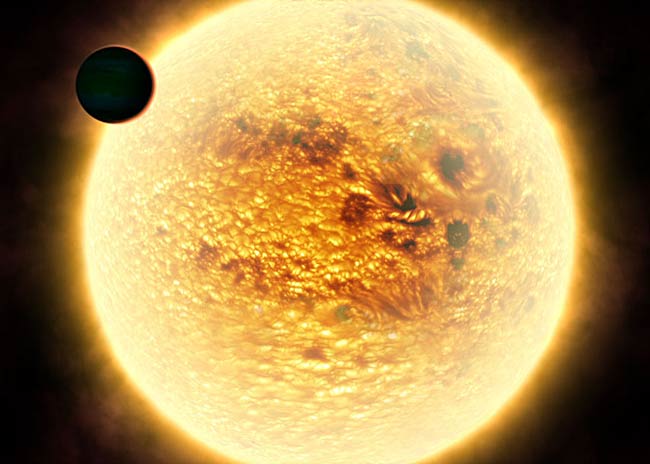First Sunset Outside Our Solar System Glimpsed

Traces of a distant extrasolar planet's hazyred sunset have been detected for the firsttime.
Astronomerspointed the Hubble Space Telescope HD 189733b, a gaseous Jupiter-like world about63 light-years from Earth, as it passed in front of its parent star to catch aglimpse of the planet's atmosphere. Previous observations have notrevealed much about the planet's atmosphere, other than that ithas clouds.
"Oneof the long-term goals of studying extrasolar planets is to measure theatmosphere of an Earth-like planet [and] this present result is a step in thisdirection," said Frederic Pont, an astronomer at the Geneva UniversityObservatory in Switzerland. Pont led the team of astronomers who made the newHubble observations.
"HD189733b is the first extrasolar planet for which we are piecing together acomplete idea of what it really looks like," Pont said.
Starlightpassing through a planet's outer atmosphere can take on different colors as itpasses through different gases. In the case of HD 189733b, scientists said thelight traveling through the planet's hazy atmosphere appeared red in front ofits yellow star, which is about 76 percent of the diameter of the sun.
Theyexpected to see the fingerprints of sodium, potassium and water in the redhaze, but instead discovered iron, silicate and aluminum oxide (which sapphiregems are made of). The composition is similar to Venus and Saturn's moon Titan—bothworlds with chokingly thick air.
So far, HD189733b isn't thought to harbor any Earth-sized moons or Saturn-like rings, butmore powerful telescopesof the future might detect them.
Get the Space.com Newsletter
Breaking space news, the latest updates on rocket launches, skywatching events and more!
- VOTE: The Best Hubble Images
- Top 10 Most Intriguing Extrasolar Planets
- Video: Planet Hunter
Join our Space Forums to keep talking space on the latest missions, night sky and more! And if you have a news tip, correction or comment, let us know at: community@space.com.
Dave Mosher is currently a public relations executive at AST SpaceMobile, which aims to bring mobile broadband internet access to the half of humanity that currently lacks it. Before joining AST SpaceMobile, he was a senior correspondent at Insider and the online director at Popular Science. He has written for several news outlets in addition to Live Science and Space.com, including: Wired.com, National Geographic News, Scientific American, Simons Foundation and Discover Magazine.









